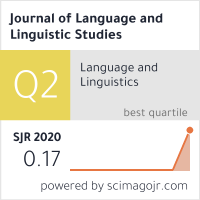Causality related to coreferential and reciprocal structures in Ewe
Abstract
This paper examines how causality is related to coreferential and reciprocal structures, looking at how they are conceived and expressed in Ewe. It deals with one particular type of causative constructions, namely the periphrastic causative construction, where the CAUSER is coreferential with the CAUSEE. This is the case where the CAUSER and the CAUSEE refer to one and the same person. For a more adequate description of this causative phenomenon in Ewe, two types of linguistic data are employed in this paper: textual and introspective. The textual data are composed of didactic materials which include popular story books and descriptions of folklore, customs and traditions, pseudo-literary plays and narratives published by the Bureau of Ghana Languages. All instances of the causative situation were extracted, with a careful consideration of the surrounding contexts so as to allow for a correct interpretation in the analyses (as context is often crucial for a correct semantic analysis and interpretation of causative forms). This paper identifies that just as English and other languages do, it is possible to express threefold coreferentiality in Ewe; where the causer is coreferential with the causee and the patient. It can also be identified that only verbs that can take the same semantic participant types as both subject and object can be reflexivized and reciprocalized; else, prototypical semantically-transitive verbs can be reflexivized only metaphorically.
Keywords
Full Text:
PDFReferences
Anonymous Author. (1975; 1976). Nunyamↄ 2A, 2B, 4 and 6. Accra: Bureau of Ghana Languages in Association/ FEP International Private Limited.
Baron, N. S. (1974). The Structure of English Causatives. Lingua, Vol. 33, pp. 299-342.
Bishop, N. (1992). A Typology of Causatives, Pragmatically Speaking. In B. A. Donald & M. R. William (Eds.), Language in Context: Essays for Robert E. Longacre. Arlington: The Summer Institute of Linguistics, Inc./University of Texas.
Born, M. (1949). Natural Philosophy of Cause and Chance. Oxford: The Clarendon Press.
Bugaeva, A. (2015). Causative constructions in Ainu: A typological perspective with remarks on the diachrony. STUF-Language Typology and Universals, 68(4), 439-484.
Comrie, B. (Ed.) (1983). Causative Constructions. Language Universals and Linguistic Typology: Syntax and Morphology. Oxford: Basil Blackwell Publishers Ltd.
Comrie, B. (1989). Language Universals and Linguistic Typology: Syntax and Morphology (2nd ed.). Oxford: Blackwell Publishers.
Croft, W. (1990). Possible Verbs and the Structure of Events. In S. Tsohatsidis (Ed.), Meanings and Prototypes, 48-73. New York: Routledge.
Croft, W. (2012). Verbs: Aspect and Causal Structure. Oxford: Oxford University Press.
Dixon, R. W. M. (2000). A Typology of Causatives: Form, Syntax and Meaning. In R. W. M. Dixon & A. Y. Aikhenvald (Eds.), Changing Valency: Case Studies in Transitivity. Cambridge: Cambridge University Press.
Evans, N., Alice, G., & Rachel, N. (2007). Valency Mismatches and the Coding of Reciprocity in Australian Languages. Linguistic Typology, 11, pp. 97-541.
Escure, G. (2008). Pidgins/Creoles and Discourse. In K. Silvia & S. J. Victor (Eds.), The Handbook of Pidgin and Creole Studies (pp. 567-92). Malden, MA: Blackwell Publishing Ltd.
Gilquin, G. (2007). Causing Oneself to do Something: The Psychodynamics of Causative Constructions. In E. M. Bermudez & L. R. Miyares (Eds.), Linguistics in the Twenty First Century (pp. 37-46.). Cambridge: Cambridge Scholars Press.
Gilquin, G. (2010). Corpus, Cognition and Causative Constructions. Philadelphia: John Benjamins Publishing Company.
Givón, T. (2001). Syntax: An Introduction, Vol. 2. Philadelphia: John Benjamins Publishing Company.
Kamlah, A. (1991). The Causal Relation as the Most Fundamental Fact of the World. Comments on Hans Reichenbach's Paper: The Space Problem in the New Quantum Mechanics. Erkenntnis, 35, 49-60.
Kenny, D. A. (2004). Correlation and Causality. Storrs: Connecticut.
Klein-Andreu, F. (1983). Grammar in Style: Adjective Placement in Spanish. In K. A. Flora (Ed.), Discourse Perspectives on Syntax (pp. 143-79). New York: Academic Press.
Kouwenberg, S., & Singler, J. V. (Eds.). (2008). The Handbook of Pidgin and Creole Studies. United Kingdom: Blackwell Publishing Ltd.
Lakoff, G. & Johnson, M. (1980). Metaphors We Live By. Chicago: University of Chicago Press.
Langacker, R. W. (1991). Foundations of Cognitive Grammar, Vol. II: Descriptive Application. Stanford: Stanford University Press.
Lee, D. (2001). Cognitive Linguistics. An Introduction. Oxford: Oxford University Press.
Meyer, P. G. (2000). The Relevance of Causality. In C. K, Elizabeth & K. Bernd (Eds.), Topics in English Linguistics 33: Cause, Condition, Concession, Contrast: Cognitive Discourse Perspectives. New York: Mouton de Gruyter.
Li, Y. (1999). Cross-Componential Causativity. Natural Language & Linguistic Theory, 17(3), pp. 445-497.
Nyaku, K. F. (1973). Amedzro Etlia. Accra: The Bureau of Ghana Languages in Association/FEP International Private Limited.
Saah, K. (1989). Reflexivization in Akan. Journal of West African Languages, Vol. 19(2), pp. 15-28.
Sabato, S., & Winter, Y. (2005). Against Partitioned Readings of Reciprocals. In D. Paul & F. Michael (Eds.), Proceedings of the Fifteenth Amsterdam Colloquium. Amsterdam: ILLC/Department of Philosophy, University of Amsterdam.
Saha, P. K. (1987). Reflexivization in American English. Journal of American Speech, 62(3), pp. 211-234.
Salmon, W. C. (1997). Causality and Explanation. Pennsylvania: University of Pittsburgh.
Shibatani, M. (1976). The Grammar of Causative Constructions: A Conspectus. In S. Masayoshi (Ed.), The Grammar Causative Constructions (Syntax Semantics, 6). New York: Academic Press.
Song, J. J. (2001). Causatives and Causation: A Universal-typological Perspective. London: Longman.
Stefanowitsch, A. (2001). Constructing Causation: A Construction Grammar Approach to Analytic Causatives. Ph.D Thesis. Ann Arbor: Bell & Howell Information and Learning Company.
Talmy, L. (2000). Toward a Cognitive Semantics: Concept Structuring Systems, Volume 1. Cambridge: MIT Press.
Ungerer, F., & Schmid, H. J. (2006). An Introduction to Cognitive Linguistics (2nd ed.). Harlow: Pearson Education.
Ungerer, F. and Schmid, H. J. (2006). An Introduction to Cognitive Linguistics, Second Edition. Harlow: Pearson Education.
Refbacks
- There are currently no refbacks.

This work is licensed under a Creative Commons Attribution-NonCommercial-NoDerivatives 4.0 International License.
ISSN 1305-578X (Online)
Copyright © 2005-2022 by Journal of Language and Linguistic Studies
